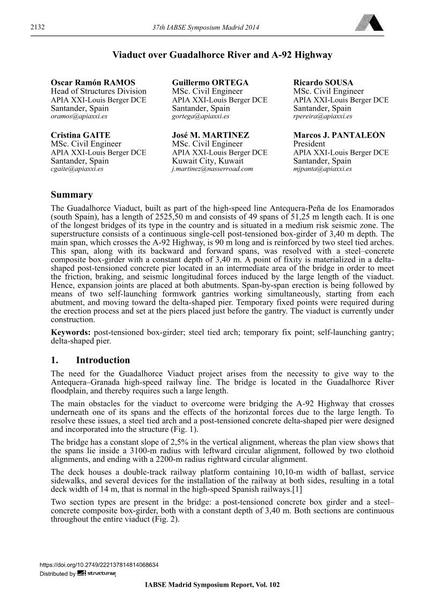Viaduct over Guadalhorce River and A-92 Highway

|
|
|||||||||||
Bibliografische Angaben
| Autor(en): |
Óscar Ramón Ramos
Guillermo Ortega Ricardo Sousa Cristina Gaite José M. Martínez Marcos J. Pantaleón |
||||
|---|---|---|---|---|---|
| Medium: | Tagungsbeitrag | ||||
| Sprache(n): | Englisch | ||||
| Tagung: | IABSE Symposium: Engineering for Progress, Nature and People, Madrid, Spain, 3-5 September 2014 | ||||
| Veröffentlicht in: | IABSE Symposium Madrid 2014 | ||||
|
|||||
| Seite(n): | 2132-2139 | ||||
| Anzahl der Seiten (im PDF): | 8 | ||||
| Jahr: | 2014 | ||||
| DOI: | 10.2749/222137814814068634 | ||||
| Abstrakt: |
The Guadalhorce Viaduct, built as part of the high-speed line Antequera-Peña de los Enamorados (south Spain), has a length of 2525,50 m and consists of 49 spans of 51,25 m length each. It is one of the longest bridges of its type in the country and is situated in a medium risk seismic zone. The superstructure consists of a continuous single-cell post-tensioned box-girder of 3,40 m depth. The main span, which crosses the A-92 Highway, is 90 m long and is reinforced by two steel tied arches. This span, along with its backward and forward spans, was resolved with a steel–concrete composite box-girder with a constant depth of 3,40 m. A point of fixity is materialized in a delta- shaped post-tensioned concrete pier located in an intermediate area of the bridge in order to meet the friction, braking, and seismic longitudinal forces induced by the large length of the viaduct. Hence, expansion joints are placed at both abutments. Span-by-span erection is being followed by means of two self-launching formwork gantries working simultaneously, starting from each abutment, and moving toward the delta-shaped pier. Temporary fixed points were required during the erection process and set at the piers placed just before the gantry. The viaduct is currently under construction. |
||||
